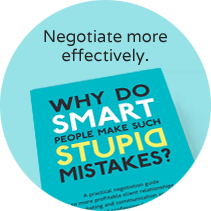Insights

Are your briefs embarrassing?
Why do we accept poor briefs? We assume the client knows what they want. In reality clients know their business (hopefully) but won’t be experts at our business. In my work with sales people it is common for them to chase a deal and to be so excited by the potential opportunity they fail to qualify the opportunity and do due diligence on the brief accepting the brief at face value.
Here are my top tips to get a great brief.
- Push for a great brief.
It all starts with a great brief but too often we accept a poor brief and then live to regret it. I regularly hear stories from my clients about how they accepted a poor brief which then led to huge problems for the company. Examples of problems are: The end result doesn’t match the client’s expectation, lots of unnecessary re-work to understand what the client does want, briefs from junior clients who don’t have the bigger picture, unrealistic briefs and expectations for the budget or deadline.
- Written briefs rule.
“Verbal briefs aren’t worth the paper they’re not written on” Accepting a verbal brief is dangerous. It is open to interpretation and ambiguity. If your client can’t even be bothered to write down their thoughts, how important is this project really for them? If the client really won’t write a brief then write down your understanding and get the client to sign it off. Do that before starting your proposal. Make sure the decision maker sees the brief.
- Beware of suspicious briefs.
Phantom briefs can be very frustrating. This is when the client briefs several providers, accepts all their hard worked proposals and then appoints no one, instead choosing to manage the project internally using the free consultancy and thinking from the different providers. I’m not expecting to win every project but I do expect it to be a fair fight whereby one of us is appointed. Listen to your instincts.
- It’s your responsibility.
Develop a bank of great questions fine tuned to your specific business/industry. Hone and craft these questions over time and in discussion with colleagues. Push for a clear objective(s) and beware of vagueness. Get an understanding of the client’s budget before starting work. By asking great incisive questions you get a better brief, you’ve demonstrated your expertise and built rapport with the client. I always find face to face is best as it is easier to pick up what’s not said and to build the relationship and trust.
- Answer the brief …and some!
Ensure you answer the brief. It’s easy to be distracted and answer a brief in our head. We then miss a key point important to the client. When you’ve answered the brief go one step further. Be proactive and think what else might the client need if they agree to our proposal?
- Use the brief to help sell your proposal.
Remind the client before you present you proposal of the key points from their brief but don’t regurgitate it as that will frustrate them. Use the salient points to set up and frame your proposal.
If you take the actions above how much more profitable will your business be?
Published in Sales Initiative
no comments
